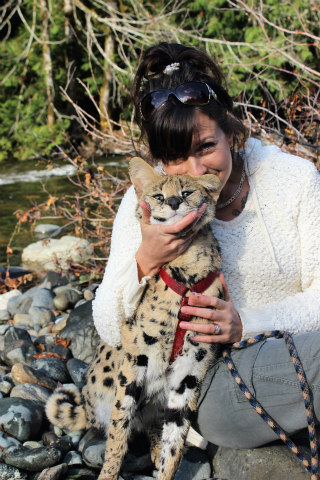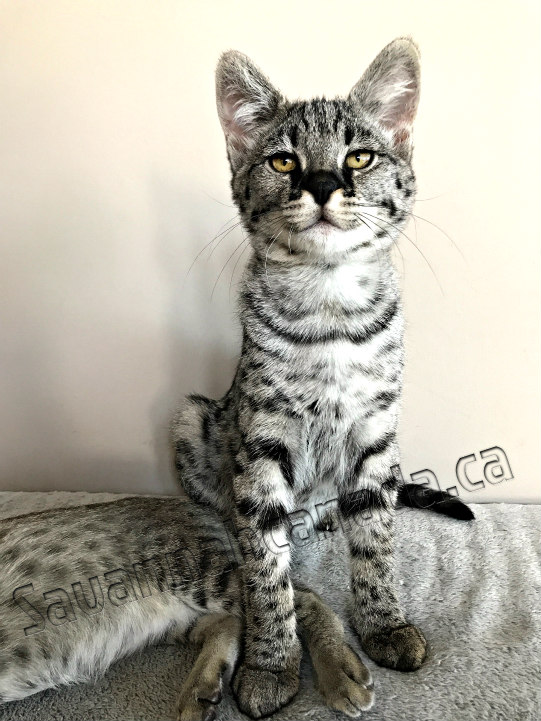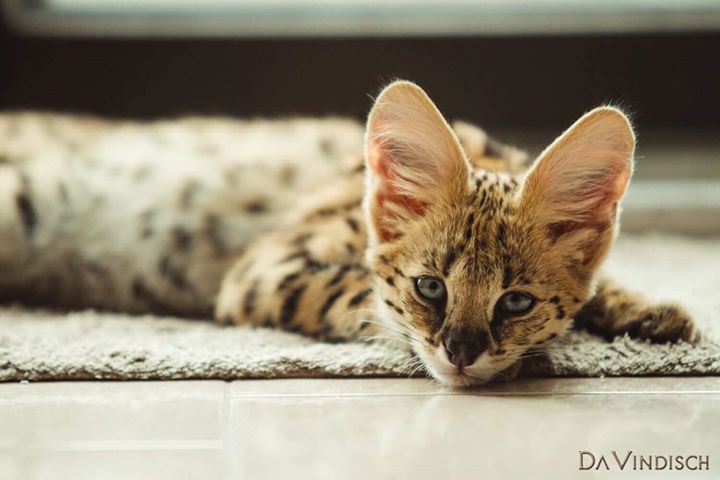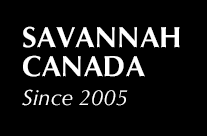About Savannah Canada
About me
Welcome to Savannah Canada. My name is Catherine Joyal and I’m the proud owner of the Savannah Canada cattery.
As far as I can remember, I have always loved animals. Not just cats and felines, but all of them, from the bear to the ant. My parents even had problems feeding me because I didn’t want to eat the animals that I loved so much. That’s how I loved and still love animals.
In 2005, owning cats and dogs, I started to look into becoming a breeder and what was the involvement required to be the best one. I’ve focused into the breeding, the genetics and the welfare of each parents and kittens born at home. The physical and mental health were my main priorities and still is.
I gave birth to a hundred kittens in more than ten years. I have started breeding Sphynx, Lykoi cats and Savannah’s and fell in love with this last one. My cattery is now breeding only Savannahs and in 2018, our Servals Capone and Cassyopee, have successfully breed 2 magnificent Serval cat.
Breeding serval cats was just the logic continuation since we already have the experience with high generation savannah cats. It is important to know that we carefully choose parents through DNA testing (optimal selection). All along with their youth, our future serval and savannah parents are followed by a team of veterinarians with experience with serval and savannah cats, the Sooke Vet Hospital. They are taken care of with their diet (special diet for the Serval cats), regularly dewormed and vaccination up to date.
Our breeder
Our breeders welfare is exceptionally important to help them give birth and raise healthy babies. We offer a quiet and clean place to give birth to those little savannah and serval cats.
They also benefit from all the care and education coming from their mother and also from a human warmth all at the same time of their birth. Moms are treated with all due respect and can enjoy their maternal joys until they decide by themselves that it is time to move on to something else.
As our babies, they are fed naturally with the milk of their mother and quietly they are introduced to quality food. Our exceptional trust relationship helps the babies to adapt well with the babies as soon as they are given birth. It is by far the key to our success of very social and balanced babies.
About the breed
History
A Savannah cat is a cross between a domestic cat and the serval, a medium-sized, large-eared wild African cat. The unusual cross became popular among breeders at the end of the '90s, and in 2001 the International Cat Association accepted it as a new registered breed. In May 2012, TICA accepted it as a championship breed.
Savannahs are much more social than typical domestic cats, and they are often compared to dogs in their loyalty. They can be trained to walk on a leash and even taught to play fetch. Bengal breeder Judee Frank crossbred a male serval, belonging to Suzi Woods, with a Siamese (domestic cat) to produce the first Savannah cat (named Savannah) on April 7, 1986. Frank’s Savannah attracted the interest of Patrick Kelley, who purchased one of Savannah's kittens in 1989.
Kelley was one of the first enthusiasts who worked towards establishing a new domestic breed based on a serval/domestic cat cross. He approached many serval breeders to help in the development of this new breed, and finally garnered the help of breeder Joyce Sroufe to work with him in taking the steps needed to have the new breed recognized.
Special features
Savannah cats are the largest breed of domesticated cats. The Savannahs are tall and slim build gives them the appearance of greater size than their actual weight.
Welcome to Savannah Canada. My name is Catherine Joyal and I’m the proud owner of the Savannah Canada cattery. As far as I can remember, I have always loved animals. Not just cats and felines, but all of them, from the bear to the ant. My parents even had problems feeding me because I didn’t want to eat the animals that I loved so much. That’s how I loved and still love animals. In 2005, owning cats and dogs, I started to look into becoming a breeder and what was the involvement required to be the best one. I’ve focused into the breeding, the genetics and the welfare of each parents and kittens born at home. The physical and mental health were my main priorities and still is. I gave birth to a hundred kittens in more than ten years. I have started breeding Sphynx, Lykoi cats and Savannah’s and fell in love with this last one. My cattery is now breeding only Savannahs and in 2018, our Servals Capone and Cassyopee, have successfully breed 2 magnificent Serval cat. Breeding serval cats was just the logic continuation since we already have the experience with high generation savannah cats. It is important to know that we carefully choose parents through DNA testing (optimal selection). All along with their youth, our future serval and savannah parents are followed by a team of veterinarians with experience with serval and savannah cats, the Sooke Vet Hospital. They are taken care of with their diet (special diet for the Serval cats), regularly dewormed and vaccination up to date.

History
A Savannah cat is a cross between a domestic cat and the serval, a medium-sized, large-eared wild African cat. The unusual cross became popular among breeders at the end of the '90s, and in 2001 the International Cat Association accepted it as a new registered breed. In May 2012, TICA accepted it as a championship breed. Savannahs are much more social than typical domestic cats, and they are often compared to dogs in their loyalty. They can be trained to walk on a leash and even taught to play fetch. Bengal breeder Judee Frank crossbred a male serval, belonging to Suzi Woods, with a Siamese (domestic cat) to produce the first Savannah cat (named Savannah) on April 7, 1986. Frank’s Savannah attracted the interest of Patrick Kelley, who purchased one of Savannah's kittens in 1989. Kelley was one of the first enthusiasts who worked towards establishing a new domestic breed based on a serval/domestic cat cross. He approached many serval breeders to help in the development of this new breed, and finally garnered the help of breeder Joyce Sroufe to work with him in taking the steps needed to have the new breed recognized.Special features

Size is very dependent on generation and sex, with F1 hybrid male cats usually being the largest. F1 and F2 generation hybrids are usually the largest, due to the stronger genetic influence of the African serval ancestor. Male Savannahs tend to be larger than females.
Early-generation Savannahs can weigh 20 lbs (9 kg) or more, with the higher weight usually attributed to the F2 or F3 neutered males, though this is not a standard. Later-generation Savannahs are usually between 7 and 30 lbs (7 to 14 kg). Because of the random factors in Savannah hybrid genetics, size can vary significantly, even in the very same litter.
The coat of a Savannah depends on the breed of cat used for the domestic cross. Early generations have some form of dark spotting on a lighter coat, and many early breeders employed "wild-looking" spotted breeds, such as the Bengal and Egyptian Mau, for the cross to help preserve these markings in later generations. The International Cat Association (TICA) breed standard calls for:
- Brown-spotted tabby (cool to warm brown, tan or gold with black or dark brown spots)
- Silver-spotted tabby (silver coat with black or dark grey spots)
- Black (black with black spots)
- Black smoke (black-tipped silver with black spots)
In addition, the Savannah can come in nonstandard variations such as the classic or marble patterns, snow coloration (point), and blue or other diluted colors derived from domestic sources of cat coat genetics.
Most breeders are trying to cull these nonstandard colours out of the gene pool by selling nonstandard coloured cats as pets, but some Savannah breeders are interested in working with these colours to introduce them as new traits. The overall look of an individual Savannah depends greatly on generation, with higher-percentage Savannah cats often having a «wilder» look. The domestic breed used will influence appearance, as well. The domestic outcrosses for the Savannah breed that are permissible in TICA are the Egyptian Mau, the Ocicat, the Oriental Shorthair, and the Domestic Shorthair. In addition, some Savannah breeders use "impermissible" breeds or mixes, such as Bengal (for size and vivid spotting) and Maine Coon cats (for size) for the domestic parentage, but these outcrosses can bring many unwanted genes, as well. Outcrosses are rarely used these days, as many fertile males are available, and as a result, most breeders are exclusively breeding Savannahs to Savannahs.
The main exception would be when using a serval to produce F1 cats, and even then breeders prefer to use a Savannah with the serval, rather than a non-Savannah female. A Savannah's wild look is often due to the presence of many distinguishing serval characteristics. Most prominent of these include the various color markings; tall, deeply cupped, wide, rounded, erect ears; very long legs; fat, puffy noses, and hooded eyes.
The bodies of Savannahs are long and leggy; when a Savannah is standing, its hind-end is often higher than its prominent shoulders. The small head is taller than wide, and it has a long, slender neck. The backs of the ears have ocelli, a central light band bordered by black, dark grey or brown, giving an eye-like effect. The short tail has black rings, with a solid black tip. The eyes are blue as a kitten (as in other cats), and may be green, brown, gold or a blended shade as an adult. The eyes have a "boomerang" shape, with a hooded brow to protect them from harsh sunlight. Ideally, black or dark "tear-streak" or "cheetah tear" markings run from the corner of the eyes down the sides of the nose to the whiskers, much like that of a cheetah.
Most F1 generation Savannahs will possess many or all of these traits, while their presence often diminishes in later generations. Being a newly developing, hybridized breed of cats, appearance can vary far more than cat owners may expect.
Temperament
Savannahs are commonly compared to dogs in their loyalty, and they will follow their owners around the house like a dog. They can also be trained to walk on a leash, and even fetch. Some Savannahs are reported to be very social and friendly with new people and other cats and dogs, while others may run and hide or revert to hissing and growling when seeing a stranger. Exposure to other people and pets is most likely the key factor in sociability as Savannah kittens grow up. An often-noted trait of the Savannah is its jumping ability. They are known to jump on top of doors, refrigerators and high cabinets. Some Savannahs can leap about 8 feet (2.5 m) high from a standing position. Savannahs are very inquisitive and have been known to get into all sorts of things. They often learn how to open doors and cupboards, and anyone buying a Savannah will likely need to take special precautions to prevent the cat from getting into trouble.
Many Savannah cats do not fear water and will play or even immerse themselves in water. Some owners even shower with their Savannah cats. Presenting a water bowl to a Savannah may also prove a challenge, as some will promptly begin to "bat" all the water out of the bowl until it is empty, using their front paws. Another quirk Savannahs have is to fluff out the base of their tails in a greeting gesture. This is not to be confused with the fluffing of fur along the back and full length of the tail in fear. Savannahs will also often flick or wag their tails in excitement or pleasure. Vocally, Savannahs may either chirp like their serval fathers, meow like their domestic mothers, both chirp and meow, or sometimes produce sounds which are a mixture of the two. Chirping is observed more often in earlier generations, such as F1 Savanah. They may also "hiss"—a serval-like hiss quite different from a domestic cat's hiss, sounding more like a very loud snake. It can be alarming to humans not acquainted to such a sound coming from a cat. See Capone’s chirp here.

